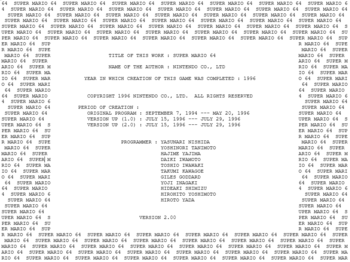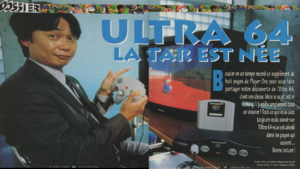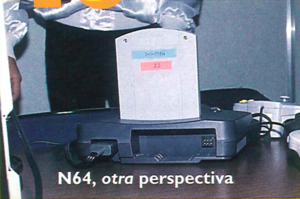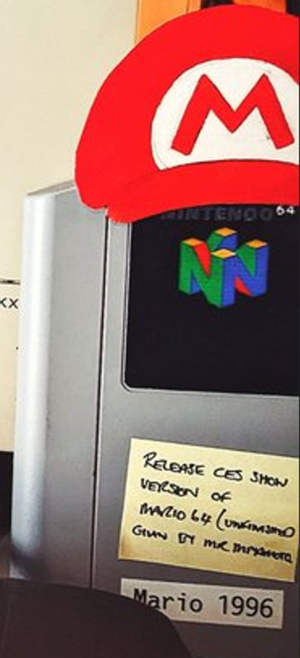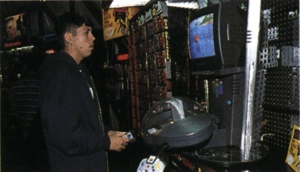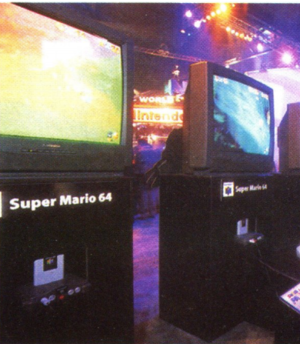Prerelease:Super Mario 64 (Nintendo 64)
This page details pre-release information and/or media for Super Mario 64 (Nintendo 64).
Super Mario 64 had a rather experimental development process, notably in the early days when three-dimensional computer graphics were first used in video games. Though much of the basic platforming gameplay was settled down, the developers tried many different ideas they had in mind for Mario's first-ever 3D outing, some of which ended up being cut due to limitations and time. Ever since release, it has become largely influential towards other 3D platformers just like how Super Mario Bros. was for side-scrollers.
To do:
|
Contents
Development Timeline
1994
- April 5 - include/yvars.h (oldest file, remnant from "Ultra 64 Test Program") is created.
- September 7 - Super Mario 64 begins development as "Ultra 64 Mario Brothers."
1995
- January 8 - include/wenemy.h is created.
- March 22 - include/shapedef.inc (oldest model list) is updated.
- May 11 - include/shapedef.h (second-oldest model list) is updated.
- June 12 - include/system.h (leftover include file in MK64) is updated.
- June 16 - The unused throwable Koopa Shell model is updated.
- June 20 - Luigi's model is updated for the final time.
- July 11 - The model animation format used by the game is finalized.
- July 18 - include/ystruct.h is created.
- August - Mario head on the title screen is created.
- September 6 - include/stage.h is created.
- September 8 - The Bullet Bill's model is created.
- September 22 - The Boo's model is created.
- October - B-Roll footage and screenshots are recorded for the upcoming Shoshinkai event.
- October 19 - Explosion effect is created.
- October 23 - The Thwomp's model is created.
- November - The Nintendo 64 (then known as "Ultra 64") is patented.
- November 8 - Mine model is created.
- November 17 - Unused spring model is created.
- November 20 - Mario's dust particles are created.
- November 22-24 - The Ultra 64 is unveiled at the seventh-annual Shoshinkai trade show in Japan along with early prototypes of two games, one of which is Super Mario 64.
- December - Initial anticipated release date. 3D Stars are created.
- December 6 - Ball model used on top of poles is created.
- December 7 - Mario's current model is backed up to mario_old in preparation for the newly-added Cap powerups.
- December 7-16 - A screenshot is taken of the current build at the time for the 1996 consumer report.
- December 16 - Mario's texture list is updated for the final time.
1996
- January 19 - A backup of all of the current Star and item box positions is made and saved as "star".
- January 31 - The Chain Chomp's ball model is created.
- February 1 - Water bomb model is added.
- February - Luigi is removed from the game.
- Early March - Inverted HUD footage is recorded.
- March - Boo Keys are scrapped, Motos and all its variants are scrapped during this period, work on Rainbow Ride finally begins.
- March 12 - Big Boo's Haunt cage model and shape/enemy1_i/booklight.shape is created.
- March 14 - Fwoosh's model is created.
- April - Second anticipated release date. B-Roll footage for E3 1996 is recorded. Blargg is scrapped during this period.
- April 25 - All Stars are finalized except for Tiny-Huge Island and Whomp's Fortress. Princess Peach and Toad's models are created.
- May 16 - A playable prototype is present at E3 1996.
- May 20 - Development on Super Mario 64 is completed.
- June - Work begins on the localization process.
- June 23 - Super Mario 64 is released in Japan.
- July 15-29 - Development of versions 1 & 2 (presumably a scrapped Japanese revision and American version) take place in this timeframe, with many adjustments and enhancements made.
- September 26 - Super Mario 64 is released in the United States.
- November 22-24 - A prototype of the cancelled 64DD version is shown at Spaceworld.
1997
- March 1 - Super Mario 64 is released in Europe and Australia. Notably, these versions include a fix to a crash that only occurred in the 64DD prototype.
- July 18 - A semi-enhanced version that features Rumble Pak support plus all the improvements and modifications of the western versions is released in Japan as 振動パック対応バージョン (Shindō Pak Taiō Version).
2002
- October 18 - Work begins on the iQue/Chinese version, based off the Rumble Pak version.
2003
- October 16 - Work is finished on the iQue version.
- November 17 - The game is released in China.
Super Mario 64 – 1996 Interview with Miyamoto
An interview believed to have come from "Super Mario 64: The Technique Guide Book", an official Japanese guide book.
Scrapped Yoshi event
I noticed Yoshi appears at the end of the game, but did you ever have plans to include Yoshi in the actual stages? Miyamoto: There was originally an event with Yoshi. We weren’t satisfied with how it came out, though, so we removed it. But since it would be a waste not to use the model we had made, we included him there at the end.
Mario Bros. style mini-game
—By the way, what happened to Luigi? Miyamoto: Well… until February, he was in the game. (laughs) Ultimately, due to memory issues, we had to take him out. Then we were going to include him in a Mario Bros. style minigame, but because most users probably only have that one controller when they first buy their N64, for that reason (and others) we decided not to.
Super Mario 64 - 1996 Roundtable Developer Interview
The source of this interview is currently unknown, but given the authenticity of the interview above and both coming from the same translator, it can be assumed to also be legitimate.
Beginnings
—Mario 64 is the lead-off title for the new Nintendo 64… but how did the project first get started? Miyamoto: Well, in the beginning… we were working on something really simple—deceptively simple, even, from the perspective of the team that would go on to finish the huge, final game. (laughs) There was a room made of simple lego-like blocks, and Mario and Luigi could run around in there, climb slopes, jump around, etc. We were trying to get the controls right with an analogue 3D stick, and once that felt smooth, we knew we were halfway there. And so, along the way, we realized wanted to create a slightly larger area for them to move around in…
Rejected Animations for Mario
—I really like all the nuance to Mario’s movement. It looks very natural. Miyamoto: That was all done by Nishida and Koizumi. I should have told them to make the jump look cooler though. (laughs) About all we told them in terms of guidance was to create as many different movements as they could. Koizumi: I didn’t think it would end up being THAT many. (laughs) Nishida: Koizumi created the animation data, and I did the programming. I counted them all up, and there were 193 different animation patterns! And if you include the 50 or so animations that we created but ultimately rejected, it comes to nearly 250.
Bob-Omb Battlefield once had a design with a river
Miyamoto: It was kind of like sculpting a diorama out of clay. First you make a very general shape. For example, with the King Bob-omb’s stage, for our initial, general design we’d have that river in the middle of the map, which you cross to reach the boss area, which is atop a big hill that you have to wind round and round as you ascend it. But say we put Mario in that map, and moving him around, we realize the river flows too fast and it sweeps him away (laughs), and that’s too hard for players, so we swap that river out for a desert valley, like Death Valley. So the form remains the same, but we gradually add more and more ideas, changing the map as we go.
Rabbit as a race companion
Miyamoto: Well, for example, when someone had an idea for the race with Koopa, I was wondering how this was going to be made into a game. (laughs) Tezuka: We had one early version where the course was more deterministic and restrictive of where you could go. You basically had to run up the mountain in a straight line. But it just didn’t feel like you were actually racing, so we changed it to the more freeform version where you have to dodge the balls as you ascend. Miyamoto: Our original idea was that you’d race against a rabbit. But racing against a rabbit, which is so fast, would be too harsh and stressful. Besides, it would be more fun to make the player lose to a koopa. (laughs)
What couldn't be added due to a tight deadline
Miyamoto: At first Mario was able to throw the rabbit too. (laughs) If we had another month, we could have added an animation where Mario tosses the rabbit by the ears… but we hit our time limit. I wanted to do it though. Tezuka: I wanted to have more monkeys, too. In an earlier version of the game, we had them in more areas, and you could chase them around. Miyamoto: If there were 3 of them together, they’d taunt Mario. Tezuka: Yeah, and if Mario caught one of them, he could toss them off of a really high cliff. (laughs) I regret we weren’t able to do more with the monkeys.
Sub-Pages
1994
| Early Development Is that the head from Mario Teaches Typing? |
1995
| Patent Material Some early stages, camera modes, and an early moveset. See, patents can be fun! |
| B-Roll Builds Promotional footage made to hype up the Ultra 64. |
| Shoshinkai 1995 Demo Water mines, a piercing voice, 2D Stars, and a ton of other stuff. |
| December 1995 Build For investors’ eyes only! |
1996
| Inverted HUD Build The first build to have a HUD similar to the final game. |
| March 1996 Build Boos contained keys? |
| "X100" Build The first build with Mario's final model. |
| Pre E3 1996 Builds The game was said to be 80% complete at this point. |
| E3 1996 Kiosk Build The last build to feature the old Mario, coin, and Star icons. |
| Manual Build Very near completion, the only major difference is the coin HUD. |
| E3 1996 Build The game is practically completely finished at this point. There are only minor differences. |
Photos of Prerelease Carts
| Super Mario 64 Prototype Cartridge (Nintendo Spaceworld 1995) | Super Mario 64 Prototype Cartridge (Nintendo Spaceworld 1995) |
|---|---|
| Cartridge of a demo that was meant to be available for play at the CES 1996 show, but Nintendo cancelled their show at the last minute. | E3 1996 Kiosk |
| E3 1996 | |
Resources
| This page or section has one or more broken YouTube links. Please find an archived version of the video(s) or a suitable replacement. |
Footage
- New, high quality footage of SSK95 and some music
- High-quality footage, including a bit of Stage1 in action
- Prerelease footage & screenshots (Broken link)
- Shoshinkai '95 footage
- Cleaner footage of Courtyard + Pause Menu + Full Bowser's Battle Intro
- Outside the castle footage, including some E3 1996 gameplay
- High quality footage with good audio & video (Broken link)
- Beta64's (very outdated) video on Super Mario 64
- Various footage 1 Similar YouTube video link
- Various footage 2 (Broken link)
- Various footage 3
- Various footage 4
- E3 1996 playable demo
- Prerelease footage, screenshots, & info from Unseen64 (One broken video link)
- New unseen prerelease footage
- "Games World on The Computer Channel Episode 06 (1996)" (Shoshinkai '95 footage)
- Newly circulated 1995 proto footage
- A complete episode of Super Mario Stadium reporting the Spaceworld '95 event. A small snippet of promotional B-Roll footage playing on one of the TV's shows Mario and Luigi jumping around in a test environment!
- Snow Slider/Tall, Tall Mountain footage from a Chinese Video Game TV show "Video Game Spectator"
- A YouTube channel focused on preserving any footage regarding the game's 1995 builds.
Images
- Prerelease footage & screenshots (Broken link)
- Prerelease info & screenshots
- Prerelease screenshots and scans (Broken link)
- Concept art (another useful link)
- Prerelease footage, screenshots, & info
- Screenshots
- Leaked high-resolution screenshots
Info
Interviews
- Interview with Giles Goddard
- Super Mario 64 DS interview (Broken link)
- Interview with Shigeru Miyamoto (Broken link)
- Super Mario Sunshine interview (another useful link)
- Nintendo 64 interview (Broken link)
- Interviews with Shigeru Miyamoto (Broken link)
- 5-page interview with Miyamoto in Next Generation #26
- Miyamoto interview
- Miyamoto GDC keynote speech
- Miyamoto & Tezuka interview
- One or more Iwata Asks that mention Mario 64
